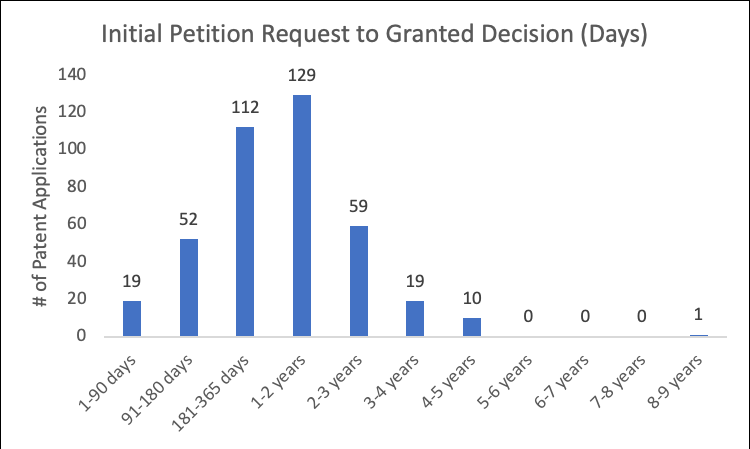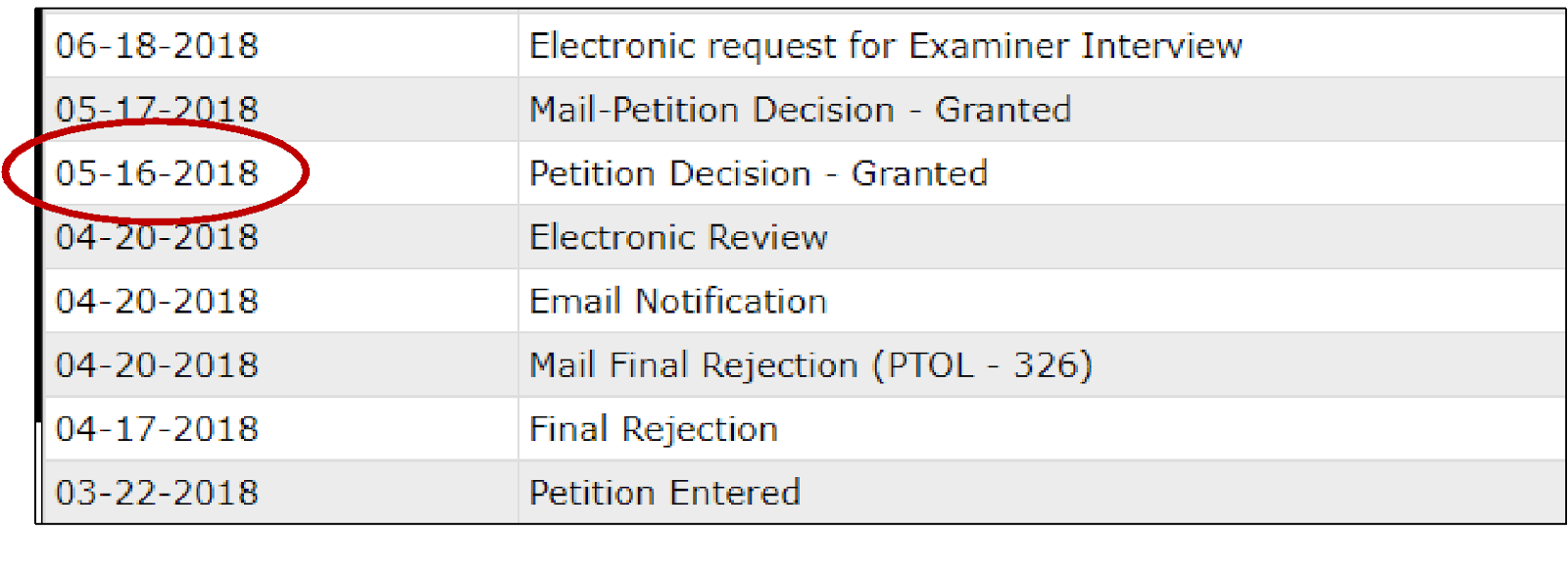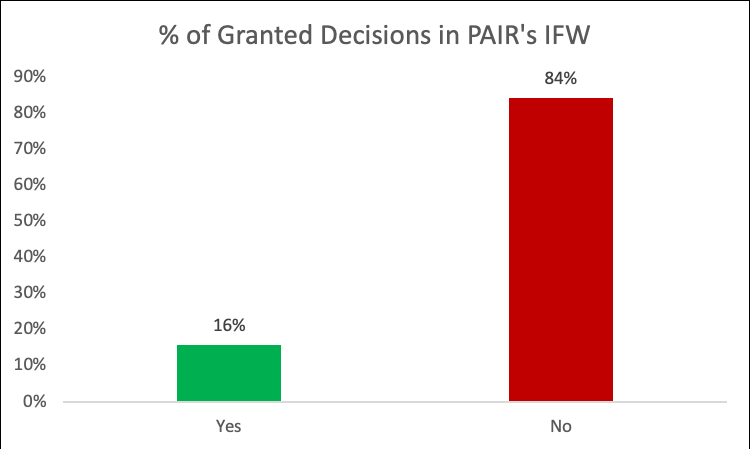The Good, the Bad and the Missing: Findings from a Review of the Data on Granted Retroactive Foreign Filing Licenses
Originally published on IPWatchdog
Michael Spector

Julie Burke, Ph.D.

"The process to obtain a RFFL, while often lengthy and arduous, is successfully accomplished over 70% of the time…. Yet, it should be concerning that 84% of the granted decisions for a RFFL are not found in Public PAIR’s Image File Wrapper."
Since launching Petition.ai’s searchable database of publicly available patent petition documents filed with the United States Patent and Trademark Office (USPTO), the most searched petition type, by far, is for a Retroactive Foreign Filing License (RFFL). Anecdotally, patent practitioners believe it is difficult, if not almost impossible, to obtain a RFFL. However, while the process may take a long time and may require several petitions, our analysis shows requests for RFFLs are often granted, eventually. A future article will examine the most common reasons why RFFL petitions are dismissed. Finally, our research uncovered some troubling issues with the substantial number of the granted petition decisions not available for public review.
Restrictions on Exporting Technical Information
In the interests of national security, the United States government imposes restrictions on the export of technical information. As a result, permission from the Commissioner for Patents under 35 U.S.C. 184 is required before filing any application for a patent in a foreign country, if the invention was made in the United States. There are two ways in which permission to file an application abroad may be obtained: (i) a petition for a foreign filing license may be granted or (ii) an applicant may wait six months after filing an application in the USPTO, at which time a license on that subject matter is no longer required, as long as no Secrecy Order has been imposed.
When Would You Need to File a Retroactive Foreign Filing License?
The penalties for failing to obtain any necessary license to file a patent application abroad include the loss of U.S. patenting rights in addition to a possible fine or imprisonment, as summarized in the June 12, 2019 IPWatchdog article entitled “Beware of Foreign Filing License Requirements”. A retroactive license may be sought if an unlicensed foreign filing has occurred through error. However, the requirements of 37 CFR 5.25 must be fulfilled in order for such a petition to be granted.
How Can You Obtain a Retroactive Foreign Filing License?
The criteria for a RFFL petition are set forth in 37 CFR 5.25 and MPEP Section 140.
a. A petition for retroactive license under 35 U.S.C. 184 shall be presented in accordance with Section 5.13 or Section 5.14(a) and shall include:
-
A listing of each of the foreign countries in which the unlicensed patent application material was filed;
-
The dates on which the material was filed in each country;
-
A verified statement (oath or declaration) containing:
- An averment that the subject matter in question was not under a secrecy order at the time it was filed abroad, and that it is not currently under a secrecy order,
- A showing that the license has been diligently sought after discovery of the proscribed foreign filing, and
- An explanation of why the material was filed abroad through error without the required license under § 5.11 first having been obtained; and
-
The required fee (§ 1.17(g) of this chapter).
b. The explanation in paragraph (a) of this section must include a showing of facts rather than a mere allegation of action through error. The showing of facts as to the nature of the error should include statements by those persons having personal knowledge of the acts regarding filing in a foreign country and should be accompanied by copies of any necessary supporting documents such as letters of transmittal or instructions for filing. The acts which are alleged to constitute error should cover the period leading up to and including each of the proscribed foreign filings.
The USPTO provides additional information about petitions for a RFFL here.
Analyzing Petition Decisions for Retroactive Foreign Filing License
By analyzing Petition.ai’s database as well as communicating with the USPTO’s Office of Petition, it appears 561 patent applications filed since 2013 include at least one petition to obtain a RFFL. Surprisingly, after methodically analyzing the file record of these applications, 401, or 71% of the applications eventually are granted a license.
Chart 1

On average, Applicants needed to file 2.3 RFFL petitions in a single application before being issued a granted decision. Chart 2 shows a distribution of the number of petition requests were filed in a single application prior to obtaining a granted RFFL license.
Chart 2

Reviewing the 401 applications with granted RFFL petitions, we found it took an average of 505 days, or 1.4 years, from when the first petition request was filed until the application was issued a granted RFFL. Chart 3 shows a distribution of the length of time it took for each application to be issued a granted RFFL. According to the USPTO’s Dashboard, it took an average of 176 days to decide each RFFL petition in 2020.
Chart 3

Where are the Granted Decisions?
In reviewing the Petition.ai database, it appeared as though the grant rate of RFFL decisions spanning 2013 – October 2020 was only 11%, significantly lower than the USPTO’s Dashboard showing a 41% grant rate in 2020. Upon further review of the USPTO’s Public Patent Application Information Retrieval (PAIR) system, we identified a sizeable number of granted petition decisions that are entered in the Transaction History of an application, but the actual decision document is not available in the Image File Wrapper (IFW). As a result, these missing granted decisions are not available to the public, not in PAIR and not in Petition.ai’s database. For example, below is the PAIR Transaction History for a granted RFFL.
Chart 4

Below is the PAIR IFW for the same patent application.
Chart 5

On March 22, 2018, Applicant filed a renewed petition for a RFFL which appears in both the IFW and Transaction History. However, the granted decision, entered into the Transaction History on May 16, 2018, is missing in the IFW. In fact, an astonishing 84% (338 of 401 decisions) of granted decisions for RFFLs are not in the Public PAIR’s IFW. The IFW, not the Transaction History, is the official file record of the application. MPEP Section 719
Chart 6

Coincidence or Design?
While the hundreds of missing granted RFFL decisions could be a coincidence, given the findings of previously co-authored articles (Part I, Part II, Part III and Part IV), it’s unlikely this occurred completely by chance. Especially troublesome, the omission of USPTO-generated documents entered or scanned into public filings, including patent applications, calls into question the integrity of the electronic file record and appears counter to the USPTO’s compliance with their Information Quality Guidelines. A clear and complete file record would necessarily include the petition decision granting the RFFL.
While trying to determine why these hundreds of granted decisions are not in Public PAIR, we spoke with the Office of Petitions (several times), the Electronic Business Center (several times), a Petitions Examiner, an Attorney Advisor, the Inventors Assistance Center, the Licensing and Review Office, the Public Records Office (several times), and the Office of Patent Legal Administration. Frustratingly, no one seemed to know who is in charge of posting documents to Public PAIR and/or why these granted decisions are unavailable in Public PAIR.
Finally, we reached out to Charles Kim, the Director of the Office of Petitions. Director Kim promptly responded to our inquiries and, through the primary RFFL Petitions Examiner, informed me the missing granted decisions will be published to Public PAIR, but it will take some time. Nevertheless, one wonders if the omission of hundreds of granted RFFL petition decisions from Public PAIR, over an eight-year period, occurred by design or coincidence and whether this omission is limited to just favorable RFFL petition decisions.
What is a Control Number R-Series Application?
While researching RFFL petitions, a new type of application number became apparent which was unfamiliar to us – Control Number R-series.


Anecdotally, it seems like many veteran patent practitioners have never previously seen or heard about this type of control number. R-series control numbers are given to petitioners for RFFLs who have yet to file their patent application with the USPTO. After asking the Office of Petitions where the public could find these R-series documents, they informed us the documents are not in Public PAIR, even after the application has published, nor are they available to the public, in general.
RFFLs Can Be Obtained – Eventually
The process to obtain a RFFL, while often lengthy and arduous, is successfully accomplished over 70% of the time. With the potentially severe consequences of not obtaining a RFFL when required, many patent practitioners will hopefully be encouraged to learn of the high likelihood their efforts will end with a granted decision, eventually.
Yet, it should be concerning that 84% of the granted decisions for a RFFL are not found in Public PAIR’s IFW, especially as it is not known whether their absence is a result of coincidence or oversight. Knowing so many RFFL granted petitions are missing from the official file record in PAIR IFW, patent practitioners might question the integrity of the USPTO electronic file and wonder what other documents are missing when searching for prior art or examining a competitor’s patent activity?


